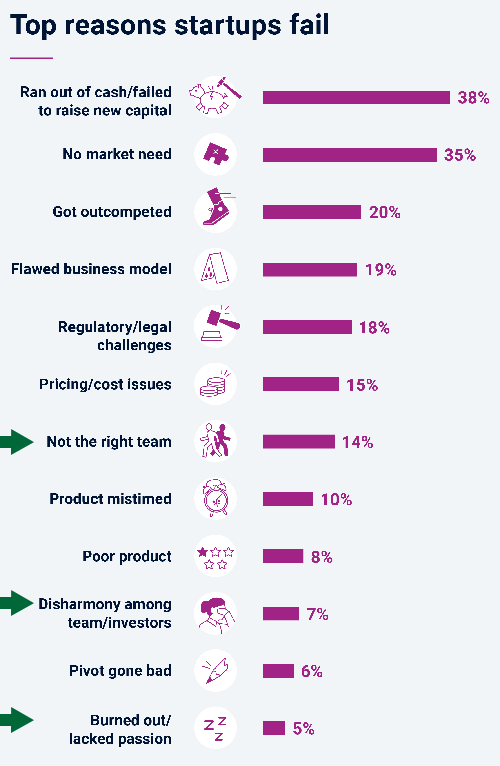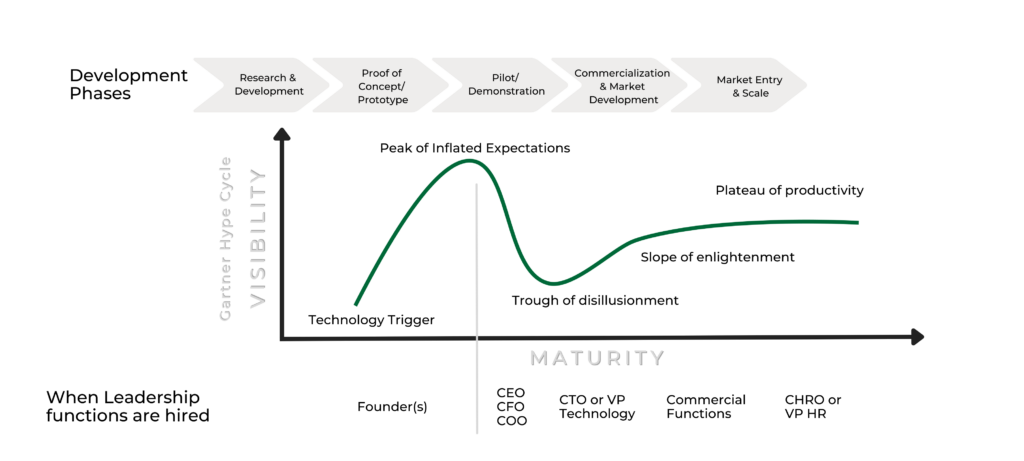Contributing Principals: Michael Whitney & Christophe Dumont
Behance Co-Founder Scott Belsky once said “It’s not about ideas. It’s about making ideas happen.” Entrepreneurs around the world have some version of that engrained in them, which is why everyday life is filled with products and services that make life more convenient.
Dozens of sources state the average failure rate for a startup is upwards of 90%,1 so the question that arises is what are the 1 in 10 doing differently?
While capital is a critical component to success for every startup, CBInsights identified a number of other reasons why startups fail2 and most are linked to the leadership needs of an early-stage company in some way.

Take into consideration that three of the reasons listed at right are directly related to the team in place, meaning more than 25% of startups are failing because the right people aren’t there. Out of those remaining reasons, several additional points like a flawed business model, poor or mistimed product, pricing/cost issues and a pivot gone bad are still reliant on the leadership within the organisation.
Recently K&R Principals Michael Whitney and Christophe Dumont spent time with incubators and senior leaders from several startups in Israel, dubbed “Startup Nation” due to having more startups per capita than anywhere else in the world.3 While the pair did discuss the founder to CEO transition, the primary focus of these conversations centered on the implications of prioritising the human capital aspect of early-stage companies and how that helps to mitigate risk and accelerate organisational growth.
Two core areas stood out during their discussions:
Every company’s growth cycle is unique, but typically leadership changes are driven by opportunities and challenges. Identifying pivotal roles and planning for them is a key objective startup founders and founder teams should undertake early on.
A point commonly heard by our principals when discussing human capital with startups and early-stage companies is the budget aspect, i.e. ‘we can’t afford to hire for that role right now.’ But if identified early enough and prioritised high enough, that statement isn’t accurate.
“Consider hiring as an investment, not a cost,” Managing Director Christophe Dumont said. “The right leaders in place often means having a better bridge between a great product and commercialisation, which can be the determining factor in success for startups.”
The product to commercialisation bridge requires not only the right leadership but the right timing, shown below in the Gartner Hype Cycle graphic.4

Knowing when to hire is just as critical as what functions should be prioritised, given how quickly startup timelines move. The average timeframe for hiring is approximately six to nine months from the time a candidate is identified and recruited, gives notice to their current employer, and onboards with the new organisation.
“Valuable time is lost by being reactionary in hiring for any organisation but especially early-stage companies and startups,” Managing Partner Michael Whitney noted. “By prioritising the people aspect, companies may find the solution to a problem that hasn’t even arrived yet.”
As a startup matures, the very structure of the company will have to evolve to ensure sustainable growth. Establishing an operating model that carefully balances fluid and stable elements is crucial according to McKinsey.5 This structure allows for agility when needing to pivot in changing market conditions while simultaneously providing structure that can be relied on to eliminate confusion and promote efficiency.
Hiring with that in mind is imperative for startups and early-stage companies, given their unpredictable and ever-evolving nature. The leadership needs of this type of organisation differ significantly from traditional business models and must be reevaluated regularly as the organisation matures, shown in the following graphic:

Knowing what core competencies are most important to the role being hired helps to evaluate candidates more effectively. In his recent discussions, Michael encouraged business leaders to not only target the core competencies that are most important to a company’s strategy, but also to focus on those that are most difficult to develop through training and experience on the job.
“Technical skills are obviously critical, however the ‘how’ and ‘why’ are just as important as the ‘what’ when hiring for leadership roles, especially in startup environments,” Michael commented. “They need disruptive leaders who are highly adaptable, innovative, and resourceful to lead an early-stage organisation.”
Another area founders and founder teams should make time for early on is defining the organisation’s culture, mission, and values. A great product and competitive salary may catch the eye of a high performer, but those aren’t enough to keep them. Retention efforts should begin before recruitment does with establishing and promoting a healthy company culture.
Culture is cyclical – good or bad – and is directly related to retention and company performance. A vibrant, innovative culture is cultivated by having the right leaders in place and may be a defining factor for many during turbulent times. If employees feel valued, the decision to stay is easier to make.
Building a high performing talent engine is imperative to early-stage companies because it’s not just the amount invested but the people executing the company’s goals that makes success attainable.
The right leader multiplies your investment, accelerating growth and ensures you go to market faster with a proven product.
2 CBInsights, The Top 12 Reasons Startups Fail
3 Forbes, The Promise & Future of Startup Nation
4 Gartner Hype Cycle with Functions
5 McKinsey, Scaling Up: How founder CEOs and teams can go beyond aspiration to ascent